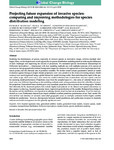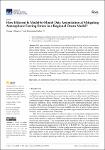Projecting future expansion of invasive species: comparing and improving methodologies for species distribution modeling
| dc.contributor.author | Mainali, KP | |
| dc.contributor.author | Warren, DL | |
| dc.contributor.author | Dhileepan, K | |
| dc.contributor.author | McConnachie, A | |
| dc.contributor.author | Strathie, L | |
| dc.contributor.author | Hassan, G | |
| dc.contributor.author | Karki, D | |
| dc.contributor.author | Shrestha, BB | |
| dc.contributor.author | Parmesan, Camille | |
| dc.date.accessioned | 2017-10-29T18:51:33Z | |
| dc.date.available | 2017-10-29T18:51:33Z | |
| dc.date.issued | 2015-12 | |
| dc.identifier.issn | 1354-1013 | |
| dc.identifier.issn | 1365-2486 | |
| dc.identifier.uri | http://hdl.handle.net/10026.1/10111 | |
| dc.description.abstract |
<jats:title>Abstract</jats:title><jats:p>Modeling the distributions of species, especially of invasive species in non‐native ranges, involves multiple challenges. Here, we developed some novel approaches to species distribution modeling aimed at reducing the influences of such challenges and improving the realism of projections. We estimated species–environment relationships for <jats:italic>Parthenium hysterophorus</jats:italic> L. (Asteraceae) with four modeling methods run with multiple scenarios of (i) sources of occurrences and geographically isolated background ranges for absences, (ii) approaches to drawing background (absence) points, and (iii) alternate sets of predictor variables. We further tested various quantitative metrics of model evaluation against biological insight. Model projections were very sensitive to the choice of training dataset. Model accuracy was much improved using a global dataset for model training, rather than restricting data input to the species’ native range. <jats:styled-content style="fixed-case">AUC</jats:styled-content> score was a poor metric for model evaluation and, if used alone, was not a useful criterion for assessing model performance. Projections away from the sampled space (<jats:italic>i.e.,</jats:italic> into areas of potential future invasion) were very different depending on the modeling methods used, raising questions about the reliability of ensemble projections. Generalized linear models gave very unrealistic projections far away from the training region. Models that efficiently fit the dominant pattern, but exclude highly local patterns in the dataset and capture interactions as they appear in data (e.g., boosted regression trees), improved generalization of the models. Biological knowledge of the species and its distribution was important in refining choices about the best set of projections. A <jats:italic>post hoc</jats:italic> test conducted on a new Parthenium dataset from Nepal validated excellent predictive performance of our ‘best’ model. We showed that vast stretches of currently uninvaded geographic areas on multiple continents harbor highly suitable habitats for parthenium. However, discrepancies between model predictions and parthenium invasion in Australia indicate successful management for this globally significant weed.</jats:p> | |
| dc.format.extent | 4464-4480 | |
| dc.format.medium | ||
| dc.language | en | |
| dc.language.iso | eng | |
| dc.publisher | Wiley | |
| dc.subject | AUC | |
| dc.subject | boosted regression trees | |
| dc.subject | generalized additive models | |
| dc.subject | generalized linear models | |
| dc.subject | invasive species | |
| dc.subject | model evaluation | |
| dc.subject | nonequilibrium distribution | |
| dc.subject | Parthenium hysterophorus | |
| dc.subject | random forests | |
| dc.subject | species distribution modeling | |
| dc.title | Projecting future expansion of invasive species: comparing and improving methodologies for species distribution modeling | |
| dc.type | journal-article | |
| dc.type | Journal Article | |
| dc.type | Research Support, Non-U.S. Gov't | |
| plymouth.author-url | https://www.webofscience.com/api/gateway?GWVersion=2&SrcApp=PARTNER_APP&SrcAuth=LinksAMR&KeyUT=WOS:000364777400016&DestLinkType=FullRecord&DestApp=ALL_WOS&UsrCustomerID=11bb513d99f797142bcfeffcc58ea008 | |
| plymouth.issue | 12 | |
| plymouth.volume | 21 | |
| plymouth.publication-status | Published | |
| plymouth.journal | Global Change Biology | |
| dc.identifier.doi | 10.1111/gcb.13038 | |
| plymouth.organisational-group | /Plymouth | |
| plymouth.organisational-group | /Plymouth/Faculty of Science and Engineering | |
| plymouth.organisational-group | /Plymouth/REF 2021 Researchers by UoA | |
| plymouth.organisational-group | /Plymouth/REF 2021 Researchers by UoA/UoA07 Earth Systems and Environmental Sciences | |
| dc.publisher.place | England | |
| dcterms.dateAccepted | 2015-06-10 | |
| dc.identifier.eissn | 1365-2486 | |
| dc.rights.embargoperiod | Not known | |
| rioxxterms.versionofrecord | 10.1111/gcb.13038 | |
| rioxxterms.licenseref.uri | http://www.rioxx.net/licenses/all-rights-reserved | |
| rioxxterms.licenseref.startdate | 2015-12 | |
| rioxxterms.type | Journal Article/Review |



